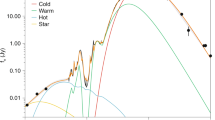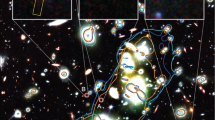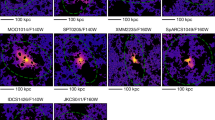Abstract
Submillimetre surveys during the past decade have discovered a population of luminous, high-redshift, dusty starburst galaxies1,2,3,4,5,6,7,8. In the redshift range 1 ≤ z ≤ 4, these massive submillimetre galaxies go through a phase characterized by optically obscured star formation at rates several hundred times that in the local Universe. Half of the starlight from this highly energetic process is absorbed and thermally re-radiated by clouds of dust at temperatures near 30 K with spectral energy distributions peaking at 100 μm in the rest frame9. At 1 ≤ z ≤ 4, the peak is redshifted to wavelengths between 200 and 500 μm. The cumulative effect of these galaxies is to yield extragalactic optical and far-infrared backgrounds with approximately equal energy densities. Since the initial detection of the far-infrared background (FIRB)10, higher-resolution experiments have sought to decompose this integrated radiation into the contributions from individual galaxies. Here we report the results of an extragalactic survey at 250, 350 and 500 μm. Combining our results at 500 μm with those at 24 μm, we determine that all of the FIRB comes from individual galaxies, with galaxies at z ≥ 1.2 accounting for 70% of it. As expected, at the longest wavelengths the signal is dominated by ultraluminous galaxies at z > 1.
This is a preview of subscription content, access via your institution
Access options
Subscribe to this journal
Receive 51 print issues and online access
$199.00 per year
only $3.90 per issue
Buy this article
- Purchase on Springer Link
- Instant access to full article PDF
Prices may be subject to local taxes which are calculated during checkout


Similar content being viewed by others
References
Smail, I., Ivison, R. J. & Blain, A. W. A deep sub-millimeter survey of lensing clusters: a new window on galaxy formation and evolution. Astrophys. J. 490, L5–L9 (1997)
Hughes, D. H. et al. High-redshift star formation in the Hubble Deep Field revealed by a submillimetre-wavelength survey. Nature 394, 241–247 (1998)
Barger, A. J. et al. Submillimetre-wavelength detection of dusty star-forming galaxies at high redshift. Nature 394, 248–251 (1998)
Greve, T. R. et al. A 1200-µm MAMBO survey of ELAISN2 and the Lockman Hole - I. Maps, sources and number counts. Mon. Not. R. Astron. Soc. 354, 779–797 (2004)
Coppin, K. et al. The SCUBA Half-Degree Extragalactic Survey - II. Submillimetre maps, catalogue and number counts. Mon. Not. R. Astron. Soc. 372, 1621–1652 (2006)
Eales, S. et al. The Canada-UK Deep Submillimeter Survey. IV. The survey of the 14 hour field. Astron. J. 120, 2244–2268 (2000)
Borys, C., Chapman, S., Halpern, M. & Scott, D. The Hubble Deep Field North SCUBA Super-map - I. Submillimetre maps, sources and number counts. Mon. Not. R. Astron. Soc. 344, 385–398 (2003)
Laurent, G. T. et al. The Bolocam Lockman Hole Millimeter-Wave Galaxy Survey: galaxy candidates and number counts. Astrophys. J. 623, 742–762 (2005)
Coppin, K. et al. The SCUBA Half Degree Extragalactic Survey - VI. 350-µm mapping of submillimetre galaxies. Mon. Not. R. Astron. Soc. 384, 1597–1610 (2008)
Puget, J.-L. et al. Tentative detection of a cosmic far-infrared background with COBE. Astron. Astrophys. 308, L5–L8 (1996)
Griffin, M. et al. The Herschel-SPIRE instrument and its capabilities for extragalactic astronomy. Adv. Space Res. 40, 612–619 (2007)
Pascale, E. et al. The Balloon-borne Large Aperture Submillimeter Telescope: BLAST. Astrophys. J. 681, 400–414 (2008)
Giavalisco, M. et al. The Great Observatories Origins Deep Survey: initial results from optical and near-infrared imaging. Astrophys. J. 600, L93–L98 (2004)
Lehmer, B. D. et al. The Extended Chandra Deep Field-South Survey: Chandra point-source catalogs. Astrophys. J. Suppl. Ser. 161, 21–40 (2005)
Lonsdale, C. J. et al. SWIRE: The SIRTF Wide-Area Infrared Extragalactic Survey. Publ. Astron. Soc. Pacif. 115, 897–927 (2003)
Lagache, G. et al. Polycyclic aromatic hydrocarbon contribution to the infrared output energy of the Universe at z ≈ 2. Astrophys. J. Suppl. Ser. 154, 112–117 (2004)
Rowan-Robinson, M. The star formation history of the Universe: an infrared perspective. Astrophys. J. 549, 745–758 (2001)
Eddington, A. S. The correction of statistics for accidental error. Mon. Not. R. Astron. Soc. 100, 354–361 (1940)
Condon, J. J. Confusion and flux-density error distributions. Astrophys. J. 188, 279–286 (1974)
Papovich, C. et al. The 24 micron source counts in deep Spitzer Space Telescope surveys. Astrophys. J. Suppl. Ser. 154, 70–74 (2004)
Fixsen, D. J., Dwek, E., Mather, J. C., Bennett, C. L. & Shafer, R. A. The spectrum of the extragalactic far-infrared background from the COBE FIRAS observations. Astrophys. J. 508, 123–128 (1998)
Dole, H. et al. The cosmic infrared background resolved by Spitzer. Contributions of midinfrared galaxies to the far-infrared background. Astron. Astrophys. 451, 417–429 (2006)
Knudsen, K. K., van der Werf, P. P. & Kneib, J.-P. Probing the submillimetre number counts at f850µm < 2 mJy. Mon. Not. R. Astron. Soc. 384, 1611–1626 (2008)
Grazian, A. et al. The GOODS-MUSIC sample: a multicolour catalog of near-IR selected galaxies in the GOODS-South field. Astron. Astrophys. 449, 951–968 (2006)
Luo, B. et al. The Chandra Deep Field-South Survey: 2 ms source catalogs. Astrophys. J. Suppl. Ser. 179, 19–36 (2008)
Hickox, R. C. & Markevitch, M. Absolute measurement of the unresolved cosmic X-ray background in the 0.5–8 keV band with Chandra. Astrophys. J. 645, 95–114 (2006)
Smail, I., Ivison, R. J., Blain, A. W. & Kneib, J.-P. The nature of faint submillimetre-selected galaxies. Mon. Not. R. Astron. Soc. 331, 495–520 (2002)
Dole, H. et al. Far-infrared source counts at 70 and 160 microns in Spitzer deep surveys. Astrophys. J. Suppl. Ser. 154, 87–92 (2004)
Acknowledgements
We acknowledge the support of NASA, the US National Science Foundation Office of Polar Programs, the Canadian Space Agency, the Natural Sciences and Engineering Research Council of Canada and the UK Science and Technology Facilities Council. We are grateful to B. Magnelli for help with the FIDEL 24-µm data. This research was enabled by the WestGrid computing resources and the SIMBAD and NASA/IPAC databases. We thank the Columbia Scientific Balloon Facility, Ken Borek Air Ltd and the mountaineers of McMurdo Station for their work.
Author information
Authors and Affiliations
Corresponding author
Supplementary information
Supplementary Information
This file contains Supplementary Data, Supplementary Tables S1-S4, Supplementary Figures S1-S8 and supplementary References. (PDF 500 kb)
Supplementary Data
This file contains Source list 1- BLASTgoods-s2006-12-21_cat250_2008-11-24_3sig_bid.dat. (TXT 187 kb)
Supplementary Data
This file contains Source List 2 - BLASTgoods-s2006-12-21_cat350_2008-11-24_3sig_bid.dat (TXT 153 kb)
Supplementary Data
This file contains Source List 3 - BLASTgoods-s2006-12-21_cat500_2008-11-24_3sig_bid.dat (TXT 118 kb)
PowerPoint slides
Rights and permissions
About this article
Cite this article
Devlin, M., Ade, P., Aretxaga, I. et al. Over half of the far-infrared background light comes from galaxies at z ≥ 1.2. Nature 458, 737–739 (2009). https://doi.org/10.1038/nature07918
Received:
Accepted:
Issue Date:
DOI: https://doi.org/10.1038/nature07918
This article is cited by
-
Spatial variations in aromatic hydrocarbon emission in a dust-rich galaxy
Nature (2023)
-
Highlights of the NASA Particle Astrophysics Program
Brazilian Journal of Physics (2014)
-
Submillimetre galaxies reside in dark matter haloes with masses greater than 3 × 1011 solar masses
Nature (2011)
-
Astronomy: Ready for boarding — finally
Nature (2010)
-
Astronomy in Antarctica
The Astronomy and Astrophysics Review (2010)
Comments
By submitting a comment you agree to abide by our Terms and Community Guidelines. If you find something abusive or that does not comply with our terms or guidelines please flag it as inappropriate.



